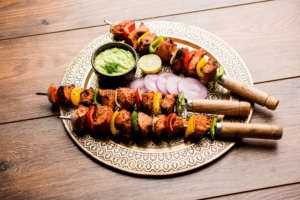DCPA NEWS CENTER
Enjoy the best stories and perspectives from the theatre world today.
Enjoy the best stories and perspectives from the theatre world today.
When someone says they love Jewish food, where does your mind go? Bagels, matzah ball soup, lox – these are all part of Jewish cuisine, but a very specific one, channeled from Eastern Europe through New York City. Those dishes belong to the Ashkenazi Jewish culture; Jewish foods from North Africa, parts of the Middle East, Spain, Greece and Turkey are known as Sephardic culture.
In fact, much of what the world knows today came from exile and poverty. Jewish delicacies came out of Biblical origins in today’s Israel and from the many countries of diaspora, beginning in 586 B.C.E. in the Babylonian Empire. The recipes span the globe, blending kosher dietary laws with the cultures in which Jews found themselves. Here are a few of the regions, and the foods that resulted, as well as local restaurants, where they exist, to have a nosh.
What Americans know as deli food tastes far different in other countries. It originated in the Pale of Settlement, a strip of today’s Russia, Poland, and the Baltic states, where it gained its unique flavor. This is why New York’s limestone-filtered water is acknowledged as the heart of the city’s bagel dominance. Locally, you can find close matches at Moe’s Bagels and Rosenberg’s, the latter of which developed a machine to recreate New York’s unique water chemistry.
Bagels are also available at delis such as New York Deli News and The Bagel, but those restaurants offer other Jewish favorites as well, such as matzah ball soup, which evolved from German knodel (knaidlach in Yiddish), incorporating matzah meal to make a part of many Passover dinners.
Ashkenazi food, while sometimes pricey today, bears the marks of poverty. Gefilte fish was made from scraps of fish that were sold cheaply. Lox and whitefish were smoked so they would keep longer. Seasoning tends to be limited to salt, onion and garlic, and cabbage and beets are prominent vegetables. Foods made cheaply from flour – challah, kreplach, kugel, kreplach – became forever associated with Ashkenazi Jews.
Unlike Ashkenazi foods, Sephardic edibles are full of spice – cardamom, cumin, turmeric and za’atar (a blend of toasted sesame seeds, sumac, and sometimes hyssop). Sephardic comes from the Hebrew word for Spain, and its culture is shared by Jews expelled by Spain in 1492. Their new homes were as far flung as Amsterdam and Marrakesh.
 As with Ashkenazi Jews, Sephardic Jews blended their new cultures in their cuisine. Burekas, today found throughout Israeli cities, are baked triangular pastries stuffed with cheese, potato and other fillings. They are closely related to pastries found throughout southern Europe and North Africa. Many other foods have Spanish influences, including fried fish, which was introduced to the United Kingdom by escaping Portugese Jews. Today, Brits call it fish and chips.
As with Ashkenazi Jews, Sephardic Jews blended their new cultures in their cuisine. Burekas, today found throughout Israeli cities, are baked triangular pastries stuffed with cheese, potato and other fillings. They are closely related to pastries found throughout southern Europe and North Africa. Many other foods have Spanish influences, including fried fish, which was introduced to the United Kingdom by escaping Portugese Jews. Today, Brits call it fish and chips.
Sharing a good deal of crossover with Sephardic cuisine is Mizrahi cooking, prepared by Jews in the Middle East, North Africa and Central Asia. This group includes Jews coming from Yemen, Iraq, Syria, Iran, Egypt, Morocco, Georgia and the other Central Asian nations. For serious picante, add a little zhug, a hot sauce made in red and green varieties.
Falafel and couscous are staples, as they are for non-Jews in those regions. Ful is a stew with fava beans as its base. Sabich is a pita sandwich featuring fried eggplant and hard-boiled eggs. Shakshuka, in which eggs are poached in a pan with tomato sauce and spices, is a staple of modern-day Israel.
 In Denver, Alon Shaya includes both Sephardic and Mizrahi dishes on the menu at his restaurant Safta, including burekas and kebabs. Root Down founder Daniel Asher opened Ash’Kara to highlight his own family’s origins. The menu includes several tagines, a dish of Moroccan origin, as well as za’atar roasted chicken.
In Denver, Alon Shaya includes both Sephardic and Mizrahi dishes on the menu at his restaurant Safta, including burekas and kebabs. Root Down founder Daniel Asher opened Ash’Kara to highlight his own family’s origins. The menu includes several tagines, a dish of Moroccan origin, as well as za’atar roasted chicken.
As they say in Hebrew, b’tayavon (bon appetit)!
